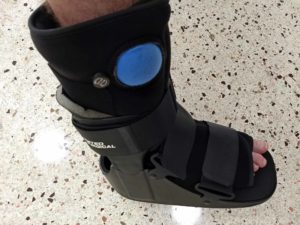As soon as it happened I knew I was in trouble.
I’ve sprained my ankles many times to varying degrees and had countless close calls. I had been lucky for a long time, but that afternoon my luck finally ran out.
For about two years, I had been playing pickup basketball games with co-workers. After playing a lot of basketball in my younger days I took a few years off in favor of running and surfing. However, after my first game back I was hooked.
The competition. Working to re-sharpen skills I once had. Team camaraderie. All of it outweighed the potential for injury even as other guys went down with torn ACLs, bruised ribs and, yes, sprained ankles. Eventually, the injury bug came to take a bite out of me as well.
By this time, I was confident enough in my skills to drive to the basket instead of settling for a jump-shot. On this play I drove to the basket and was met under the hoop by the center on the other team. He outweighs me by probably 70 pounds, and when he stepped on my foot my ankle never stood a chance.
Instead of elevating to the hoop, my foot was pinned to the court and my momentum carried me forward and to the right. My right ankle performed the classic inversion, and I heard the Velcro of my ankle brace stretch. That brace had saved me numerous times before, and I wouldn’t hesitate to recommend it to anyone, but that day it was just slightly overmatched.
I went to the ground, took a few moments to focus my breathing and then got back on my feet to assess the damage. I knew for sure it was a solid grade 2 sprained ankle, and probably more like a 2.5. I stayed on the court to close out the game, thankfully a win. Then I went to the bleachers and iced it before heading out to apply more and more ice and elevate it. I also crafted my recovery plan. One of the benefits of enduring multiple sprained ankles is that you gain knowledge with each instance.
What was my plan for healing a sprained ankle?
My first order of business was to ice the heck out of it. You’ll find all sorts of conflicting information regarding ice versus heat, how long to ice, etc. Personally, I’ve found that my body responds very favorably to icing. Plus, I knew that getting the swelling down would make it easier to walk on. I started with basic ice packs, and then, once the swelling subsided a bit, incorporated an ice pack for knee pain because it encircled the outside of my ankle perfectly.
With the swelling under control, I moved onto stability and pain relief. Due to how “loose” my sprained ankle felt I knew my regular brace wouldn’t cut it for traversing parking lots and stepping off curbs. I ended up going with one that had air bladders where I could control the pressure and a hard exterior. It worked well, though, I might recommend buying one of those shoe risers for the opposite foot because the height difference wasn’t kind to my lower back or hips. For pain relief, which was only needed after a full day of walking, I alternated between Zim’s Max Freeze and Biofreeze. I felt like the Zim’s gave better initial relief, but Biofreeze lasted longer. I never needed to take any sort of pain medication.
Next, I decided to expedite the healing process as much as I could. This came in the form of topicals, supplements, diet additives and rehab exercises. For topicals, I went with The Fay Farm Healing Hemp Salve. I feel like both their regular version and the hemp oil extract product helped reduce inflammation and improve healing. On the supplement side, I initially tried to up my collagen intake with Bulletproof collagen bars. The fudge brownie I tried wasn’t terrible, but it wasn’t great. In the end, I upped my vitamin C and alpha lipoic acid doses. I also tried to increase my servings of blueberries for their anti-inflammation properties. To round out my recovery I started resistance training about four weeks after spraining my ankle. Resistance bands let me dial in the pressure applied to the ligaments and joints, so I didn’t push it too far. Once you’ve suffered a few sprained ankles, re-injury is a common occurrence.
By now, you’re probably wondering how my sprained ankle is doing.
I’m seven weeks in, and can walk briskly, get up and down stairs and flex my ankle a little bit more each day. I might be able to lightly jog on it, but don’t feel comfortable trying just yet. Based on what I’ve read and past experience, my timeline for jogging was originally eight to 10 weeks. I feel like my treatment plan has probably shaved a week, maybe more, off that original estimate.
Remember, what works for me may or may not work for you. If you’re looking at sitting out multiple weeks of athletic competition, use that time to experiment a little bit. Find what your body responds to in terms of reducing inflammation and increasing healing. A simple vitamin increase might supercharge your body’s natural healing response.
Your ankle is already sprained so you might as well focus on finding the keys to unlock your body’s healing potential.
